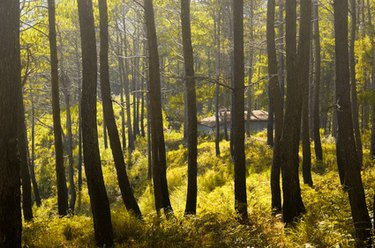
Several types of pines, called desert pine trees, grow well in dry conditions, and several factors make the desert pine tree adaptable to dryness. The biggest reasons are the trees' roots and needles. These desert pine trees are a fascinating result of the evolution of nature.
Types of Desert Pine Trees
Video of the Day
Many species of pine trees actually grow well in dry climates. The Ponderosa pine (Pinus ponderosa) is one of the most dry-hardy pine trees in the desert, according to Arbor Day. It grows in USDA hardiness zones 3 to 7. The Italian stone pine (Pinus pinea) can also tolerate dry conditions, according to Cal Poly. It grows in zones 9 and 10.
Video of the Day
The pinyon pine (Twoneedle pinyon, Singleleaf pinyon), which grows in zones 4-8, is also seen in desert conditions, as is the bristlecone pine (Pinus longaeva), which only grows in specific high altitude, mountainous locations. The Afghan pine (Pinus eldarica) is desert-hardy and originates from Afghanistan and Pakistan. The Afghan pine grows in zones 6-10 and is a shrub-like variety. All of these pines grow well in dry conditions once established.
Roots of Desert Pine Trees
The root system allows pine trees to survive dry conditions. The roots usually are as deep as the tree is tall, and longer in some instances. The Ponderosa pine contains most of its roots between two and 40 feet below the surface of the ground. The roots also are widespread, and can reach out as wide as the tree is tall. For the Ponderosa pine, this is more than 100 feet in some cases.
Other pine varieties, such as the Italian stone pine and the pinion pine. have root systems that reach 60 to 80 feet out from the trunk. This allows the roots to take in as much moisture as possible from a wide area.
Needles of Desert Pine Trees
Pine needles also play a role in the collection of moisture. Many drier climates have cooler nights, such as some deserts in the mountains. This creates a lot of condensation on the needles. The pine tree can actually absorb water through the needles and transport the water to the roots. Some pine trees have this ability and others do not.
Establishment of Desert Pine Trees
Pine trees still need water in their first few years of life. Without the large root systems and large surface area of the needles, the trees do not have the necessary tools to collect rain and ground water. For the first five years of their lives, pine trees need plenty of water.
Benefits of Desert Pine Trees
One of the greatest benefits of having pine trees in dry conditions is their adaptability. The trees provide shade, wind protection and erosion control. Many varieties of pine that grow in drier conditions have also evolved to be more fire-resistant than their moisture-loving counterparts. In fact, for the Ponderosa pine, fire is a necessity to keep the tree healthy.